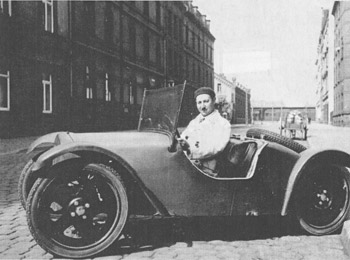In 2003, in an assembly plant in Mexico, the last classic Volkswagen Beetle rolled off the production line. It was the last in a long line of more than 21 million that had been built.
The history of the Volkswagen is fairly well-known, or so I thought. The car, designed by Ferdinand Porsche, under the careful guidance of Hitler, is one of the few successful remnants of the Nazi regime – along with the Autobahn, built especially for people to drive the Volkswagen, “the People’s Car.”
And then along comes this book, The Extraordinary Life of Josef Ganz (RVP Publishers) in which author Paul Schilperoord says that in fact the popular car was the product of the imagination of Ganz, a renegade Jewish engineer from Frankfurt.
Ganz sketched his first car as a young engineering student. He believed cars could be made lighter and safer, and from the beginning proposed that a “Volkswagen” could be sold at a price that ordinary people could afford.
At the time, in the 20s, only very rich people drove cars. At best, people drove around in incredibly unsafe motorcycles.
As a penniless student, however, he found it was impossible to build his dream car. So instead he turned to journalism, becoming the editor-in-chief of Motor-Kritik, where for five years he attacked the stagnant German car industry for designing cars that were far too expensive, ungainly, heavy, unsafe and outdated.
Ganz was rewarded for his efforts with a growing pool of readers, although he also gained criticism from the established industry who would have liked to put him out of business. In 1929, the RDA, the German auto industry, blacklisted his magazine.
The established manufacturers were not too keen to develop his ideas. They had designed and built cars according to their familiar methods for years. Who was this new upstart, a magazine editor, telling them how to do things?
But undaunted, Ganz continued to send his ideas for a small, affordable car with independent suspension, swing axles, backbone chassis and a rear-mounted engine, to various manufacturers, particularly to the motorcycle companies who were keen to develop small cars.
Ganz was offered a consulting position with various companies including Adler and Daimler Benz. This allowed him to continue editing his critical magazine.
In 1931, he built a prototype at the Adler plant which he called the Maikafer, (German May Bug). With its pointed rear and its brown colour, it really did look like a bug. It was so light that one person could lift the front off the ground.
Other companies started to show interest but as the Depression ravaged the German economy, the time was not right for full production of a Volkswagen.
It was around this time that Ganz started to have falling-outs with other engineers. One of them was his former co-editor at Motor-Kritik, Paul Ehrhardt, a man with Nazi ties, who would later become his mortal enemy.
An issue of the Nazi magazine Die Nationale Front published a rather defamatory article in which Ganz was maligned as a “Jewish engineer” and his magazine described as “poisonous excrescence.” Ganz believed that Ehrhardt was behind this article.
Although the May Bug never came to fruition, in 1932 another company, Standard, agreed to develop a car built to Ganz’s patents. The end product was named the Standard Superior. It had a front end that looked remarkably like the later VW Bug.
The car would officially be launched the next year at an exhibition in Berlin in February 1933.
By this time, Hitler had just been appointed chancellor and Ganz was thrilled by Hitler’s speech at the exhibition in which he underlined the great importance of an affordable car for all. Hitler was impressed with the Standard Superior and started to sketch his own designs, which borrowed much from Ganz’s plans, including the price of under 1,000 Reichsmarks.
Things started to go downhill rapidly for Ganz. He became the prime target of his former colleague Ehrhardt, who was now working with the SD, the state secret police. Ehrhardt – who some linked to the 1933 burning of the Reichstag – was trying to portray the activities of Ganz as a Jewish conspiracy against the Reich. Ehrhardt, an opportunist, stood to benefit if Ganz disappeared, since he could then lay claim to Ganz’s Volskwagen design for another company, Tatra, which he was associated with.
Within six months, Ganz had been dismissed as technical consultant to BMW and Daimler-Benz and lost his job at Motor-Kritik. After several arrests and patent battles, Ganz grew weary and left Germany. He spent the war years in Switzerland. Stripped off his German citizenship, he could no longer lay claim to his patents.
Hitler, meanwhile, appointed Porsche to head the consortium to develop the Volkswagen, the name now patented by the RDA.
After the war, Ganz left for Australia where his health declined rapidly and he died in 1967. After reading a book about the history of the Volkswagen, in which he was not mentioned, Ganz tried to tell the world how Hitler had stolen his plans to an Australian magazine. “The Volkswagen today principally is little different to the one I proposed in 1928. They haven’t even changed the name.”
The Volkswagen, meanwhile, took off. By 1955, the millionth bug had already been produced – but few remembered Ganz’s involvement in it. The Nazis had done a good job of wiping Ganz’s name from the history books of the Volkswagen.
The Extraordinary Life of Josef Ganz does get bogged down in technical specs and patent disputes, the reader comes away knowing far more about independent suspensions and swing axles than he probably cares to know. But Ganz’s story is an interesting one for sure, one that deserves to be told.
